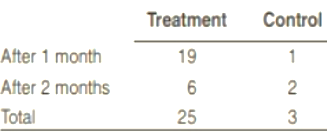
Concept explainers
(a)
To clarify: the explanation is meaningless. Then create a right two-way table that displays the experiment outcomes.
(a)
Answer to Problem 48E
Independent requirement has been not met.
Explanation of Solution
Given:

In this table, 32 participants from the treatment are not given full details. Group and 23 of the observed experimental group. So, the use of Chi-square makes no sense. The above-mentioned table exam.
The below is the product of the two-way table from the previous experiment:
| Treatment | Control | Total | |
| After 1 month | 19 | 1 | 20 |
| After 2 months | 6 | 2 | 8 |
| After 2 months don't get rid of | 7 | 20 | 27 |
| Total | 32 | 23 | 55 |
(b)
Explaining: the explanation why it is not acceptable to use the right two-way table with a chi-square test in that situation.
(b)
Answer to Problem 48E
Not proven to satisfy the random criterion.
Explanation of Solution
Given:

Formula used:
Calculation:
Expected count for any cell when
For the expected count
| Treatment | Control | Total | |
| After 1 month | 20 | ||
| After 2 months | 8 | ||
| After 2 months don't get rid of | 27 | ||
| Total | 32 | 23 | 55 |
Since at least 5 are not all expectations. So, in this situation, a chi-square test should not be carried out.
Chapter 11 Solutions
The Practice of Statistics for AP - 4th Edition
Additional Math Textbook Solutions
Intro Stats, Books a la Carte Edition (5th Edition)
Statistics for Psychology
Introductory Statistics
Statistical Reasoning for Everyday Life (5th Edition)
Statistics for Business and Economics (13th Edition)
Elementary Statistics: Picturing the World (7th Edition)
 MATLAB: An Introduction with ApplicationsStatisticsISBN:9781119256830Author:Amos GilatPublisher:John Wiley & Sons Inc
MATLAB: An Introduction with ApplicationsStatisticsISBN:9781119256830Author:Amos GilatPublisher:John Wiley & Sons Inc Probability and Statistics for Engineering and th...StatisticsISBN:9781305251809Author:Jay L. DevorePublisher:Cengage Learning
Probability and Statistics for Engineering and th...StatisticsISBN:9781305251809Author:Jay L. DevorePublisher:Cengage Learning Statistics for The Behavioral Sciences (MindTap C...StatisticsISBN:9781305504912Author:Frederick J Gravetter, Larry B. WallnauPublisher:Cengage Learning
Statistics for The Behavioral Sciences (MindTap C...StatisticsISBN:9781305504912Author:Frederick J Gravetter, Larry B. WallnauPublisher:Cengage Learning Elementary Statistics: Picturing the World (7th E...StatisticsISBN:9780134683416Author:Ron Larson, Betsy FarberPublisher:PEARSON
Elementary Statistics: Picturing the World (7th E...StatisticsISBN:9780134683416Author:Ron Larson, Betsy FarberPublisher:PEARSON The Basic Practice of StatisticsStatisticsISBN:9781319042578Author:David S. Moore, William I. Notz, Michael A. FlignerPublisher:W. H. Freeman
The Basic Practice of StatisticsStatisticsISBN:9781319042578Author:David S. Moore, William I. Notz, Michael A. FlignerPublisher:W. H. Freeman Introduction to the Practice of StatisticsStatisticsISBN:9781319013387Author:David S. Moore, George P. McCabe, Bruce A. CraigPublisher:W. H. Freeman
Introduction to the Practice of StatisticsStatisticsISBN:9781319013387Author:David S. Moore, George P. McCabe, Bruce A. CraigPublisher:W. H. Freeman





